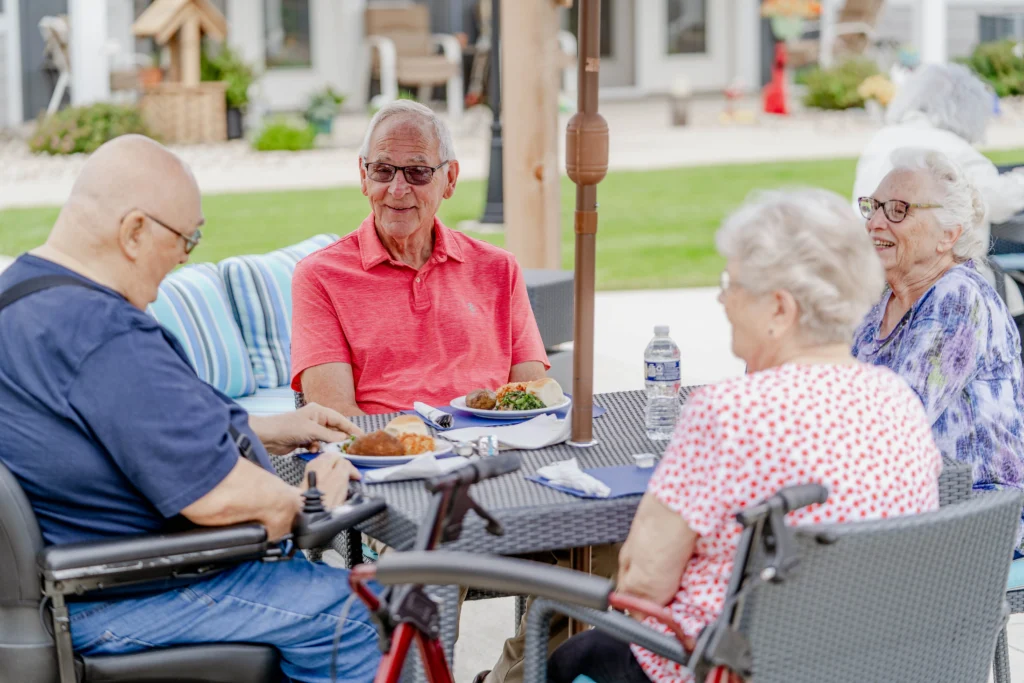SENIOR LIVING
How Senior Living Communities Differ from Nursing Homes
- Villas of Holly Brook
- July 1, 2025

SHARE
SENIOR LIVING
How Senior Living Communities Differ from Nursing Homes

When it’s time to start looking into care options for an aging parent or loved one, the choices can feel overwhelming—and sometimes, downright confusing. One of the most common points of confusion? Understanding the difference between a senior living community and a nursing home.
Although these terms are often used interchangeably, they are not the same. Each option serves a very different purpose and offers a unique level of care and lifestyle. Whether you’re exploring care for a loved one or planning ahead for yourself, knowing the difference can lead to better decisions and greater peace of mind.
Senior living communities are designed to support older adults as they age, while preserving their independence and enriching their lifestyle. These communities often offer a range of care levels, including:
What sets senior living apart is the emphasis on quality of life, not just care. Residents enjoy private or semi-private apartments, chef-prepared meals, vibrant social calendars, wellness programs, and the comfort of a safe, homelike setting.
Nursing homes, also known as skilled nursing facilities, cater to individuals who require round-the-clock medical supervision or are recovering from serious illness, surgery, or injury. They are designed more like clinical environments than residential ones.
Typical services in a nursing home include:
Many residents of nursing homes are there temporarily following a hospital stay, while others are long-term residents due to serious health issues.
Primary Focus
Independence, lifestyle, support
Medical care, rehabilitation, chronic illness care
Living Spaces
Apartment-style homes, private units, shared rooms
Shared rooms, hospital-like settings
Level of Care
Various levels of care
Skilled nursing and medical care
Social Environment
Active calendar, outings, communal dining
Limited due to health restrictions
Who It’s For
Active seniors to those needing moderate assistance
Individuals with advanced medical needs
Cost & Coverage
Typically private pay
May accept Medicare, Medicaid for qualifying stays
Senior Living: Independence, lifestyle, support
Nursing Home: Medical care, rehabilitation, chronic illness care
Senior Living: Apartment-style homes, private and shared rooms
Nursing Home: Primarily shared rooms, hospital-like settings
Senior Living: Various levels of care ranging from independent to memory care
Nursing Home: Skilled nursing and medical care
Senior Living: Active calendar, outings, communal dining
Nursing Home: Limited due to health restrictions
Senior Living: Active seniors to those needing moderate assistance
Nursing Home: Individuals with advances medical needs
Senior Living: Typically private pay
Nursing Home: May accept Medicare, Medicaid for qualifying stays
Making the right choice starts with assessing your loved one’s needs.
Ask yourself:
If your loved one is still socially and mentally active but needs help with things like meals, transportation, or getting dressed, a senior living community will likely offer the perfect balance of support and independence.
However, if they require intensive medical care, such as IV treatments, wound care, or 24/7 nursing, a nursing home may be the safer and more appropriate option.
Tip: Schedule tours of both types of facilities and ask about staffing, care levels, and activities. Seeing the environment firsthand can make your decision clearer.
We hear it all the time:
“Isn’t assisted living just another word for a nursing home?”
Let’s clear up a few common myths:
Click on the location below for more information or to contact an advisor today.
OPENING 2022